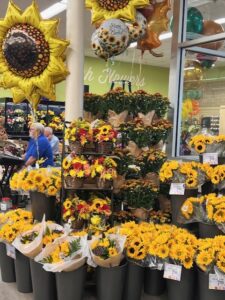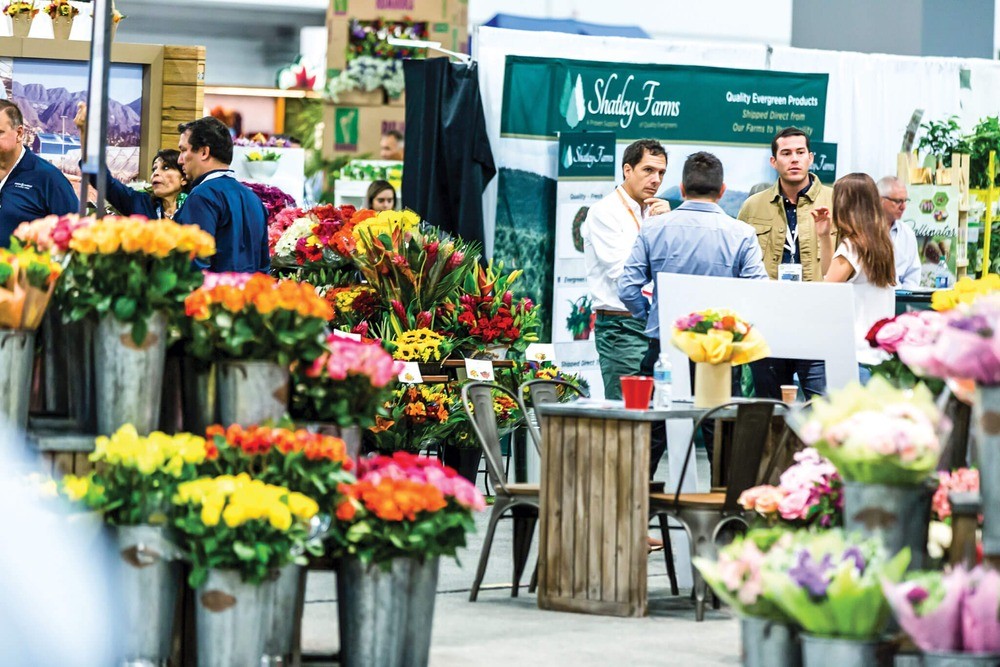Executive Summary
Valentine’s Day 2016 falls on a weekend, Sunday February 14th. Many in the U.S. floral industry believe that a weekend Valentine’s Day results in dampened floral sales. Prince & Prince (P&P) test this “theory” with historical U.S. consumer floral purchasing data for Valentine’s Day from P&P surveys conducted in 1996, 2000, 2007, 2010, and 2013. P&P compare household Valentine’s Day floral purchasing (incidence of floral purchase) when the holiday fell on weekdays (1996, 2000, 2007, 2013), and when the holiday fell on a weekend (2010).
The P&P survey data suggests a slight increase in consumer floral purchasing for Valentine’s Day when the holiday falls on the weekend, compared to weekday holidays. Of all floral-buying households that purchase for Valentine’s Day (around 49% in 2013), about two percent more households purchase for a weekend holiday, which translates into an estimated $130 million in additional floral spending for Valentine’s Day. Thus, the P&P consumer research findings refute the floral industry’s “common knowledge” related to less floral purchasing for a weekend Valentine’s Day.
The increase in weekend Valentine’s Day floral purchasing is largely driven at both ends of the household income ladder, among more mature floral-buyer segments (age 55 and older), and among single-male households. While younger-aged households (under age 35) still show strong likelihood to purchase floral products for Valentine’s Day, a weekend holiday (as in 2016) likely offers more opportunities to
target additional consumer groups to expand the market for this all-important floral holiday.
The Influence of a “Weekend” Valentine’s Day Holiday on Consumer Floral Purchasing Insight from The Prince & Prince U.S. Consumer Floral Tracking Survey
Special Note: This consumer floral research was sponsored by Smithers-Oasis North America (SONA). P&P sincerely thank SONA for their financial support in making this survey research possible, providing benefit for the entire floral industry. The 2014 U.S. Consumer Floral Tracking Survey is now available from P&P with an on-site seminar format, including Q&A session, as well as a “Seminar on Flash”.
Valentine’s Day 2016 falls on the weekend, Sunday, Feb. 14th, and aggregate U.S. consumer floral spending for this holiday has a projected retail value of $3.3 billion (Prince & Prince, 2016), ranking second behind the Mother’s Day holiday (Prince & Prince, 2015). However, members of the U.S. floral industry have often viewed a “weekend” Valentine’s Day with some trepidation, thinking that the weekend holiday would likely result in dampened consumer floral sales. Prince & Prince, Inc. (P&P), a leader in market research focused on the floral and green plant industries, has been tracking U.S. consumer household floral purchasing for Valentine’s Day (as well as 20+ other holidays, events, & occasions) for nearly 20 years with their periodic surveys nationwide (surveys in 1996, 2000, 2007, 2010, and 2013; Prince & Prince, 2014a). Thus, P&P is able to provide insight on consumer floral purchasing trends over time for specific holidays, events, and occasions, including Valentine’s Day.
Interestingly, P&P’s 2010 survey captured consumer floral purchasing for Valentine’s Day on the weekend, as Valentine’s Day fell on Sunday in 2010. Thus, P&P is able to make historical comparisons of consumer floral purchasing for Valentine’s Day when the holiday falls on a weekend (2010), and when it falls on weekdays (other survey years), and provide insight on the influence of the upcoming 2016 weekend Valentine’s Day on consumer floral sales (up, down, or no change) compared to weekday holidays. In addition, since the P&P survey tracks floral purchasing at the individual household level, P&P is able to ascertain the specific household demographic segments where the weekend floral purchasing effect is most pronounced, enabling development of marketing and business strategies targeted to specific consumer segments to bolster weekend Valentine’s Day floral sales. Table 1 shows the household demographics measured in the P&P consumer floral survey.
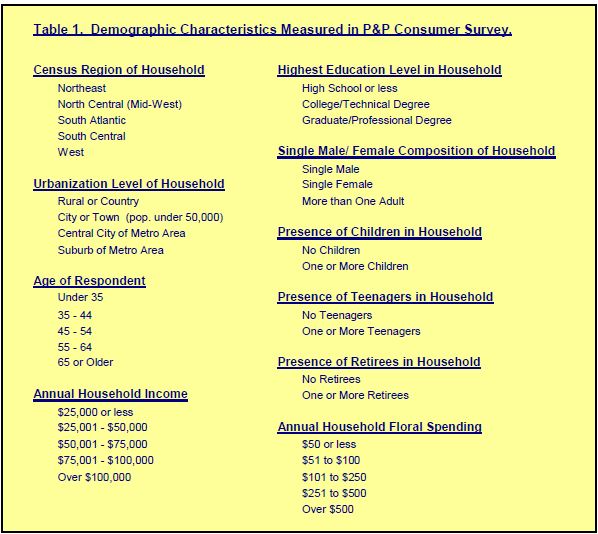
Figure 1 shows the historical U.S. household incidence of purchasing floral product for Valentine’s Day across the past five P&P consumer surveys. For 2013, 49 percent of floral-buying households in the U.S. purchased floral products for Valentine’s Day (Thursday of the week), down three percentage points since Valentine’s Day of 2010 (Sunday of the week), and the lowest purchasing incidence since P&P’s initial consumer floral survey in 1996 (53%; Wed. of the week).
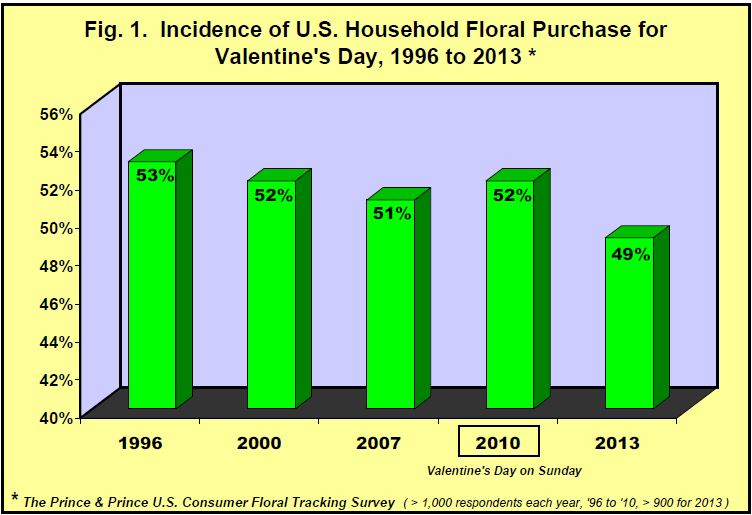
In fact, the household floral-purchasing trend across the five survey periods suggests a slight downward linear trend, as depicted in Figure 2. P&P conducted statistical trend analysis 4 on the Valentine’s Day purchasing data across the five survey years, and P&P is 75% confident 5 that the linear downward trend is real, and not due to chance. P&P has previously discussed this historical downward trend in Valentine’s Day purchasing and its implications for the industry (Prince & Prince, 2014b). P&P’s interest in this reporting is the trend associated with the 2010 survey data, when Valentine’ Day fell on a weekend.
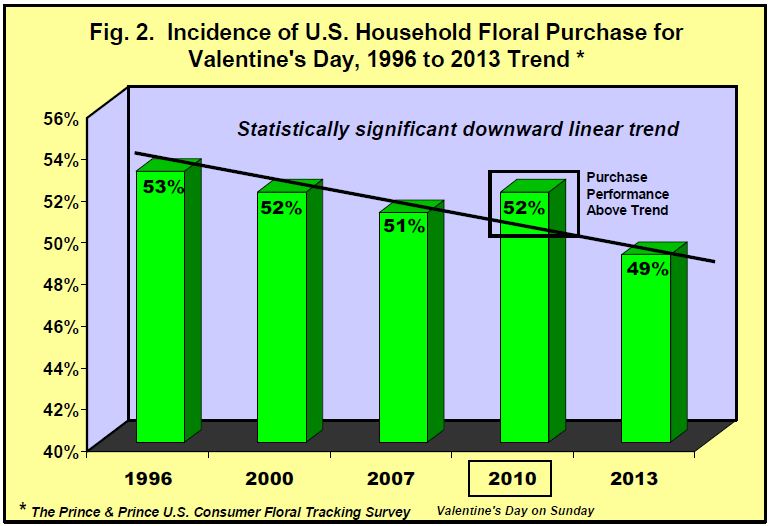
The 2010 purchasing data suggests an increase in consumer floral purchasing for Valentine’s Day (about two percentage points higher) when the holiday falls on the weekend, that is, floral purchasing above projected historical trend (largely when the holiday fell on weekdays). This higher floral purchasing trend for a weekend Valentine’s Day largely goes counter to conventional wisdom in the floral industry. And while this increase in purchasing is considered small in terms of the percentage of floral-buying households, in terms of aggregate spending, a weekend Valentine’s Day likely translates into an estimated $130 million in additional floral spending nationwide.While P&P cannot state with assurance that the relationship between increased consumer floral purchasing and the weekend holiday is causal, due to the limitations ofthe P&P survey research, an association is duly noted, and future tracking research is likely required to verify this finding 7. To better understand the demand structure of this heightened Valentine’s Day floral purchasing on the weekend, P&P segmented the historical purchasing data for Valentine’s Day by the demographic characteristics of the household, and profiled the key demos that drive higher weekend floral purchasing for this holiday. Results of that segmentation analysis follow.
Low Income and High Income Households Influence Weekend Purchasing
Households with annual income of $25,000 or less, and those households with annual income of $75,001 to $100,000 showed heightened floral purchasing for the weekend Valentine’s Day in 2010, compared to other survey years when the holiday fell on weekdays (Figure 3). The magnitude of this increase in weekend floral purchasing for these two consumer income groups is quite substantial, estimated at about a ten percentage point increase for each group attributed to the weekend Valentine’s Day.
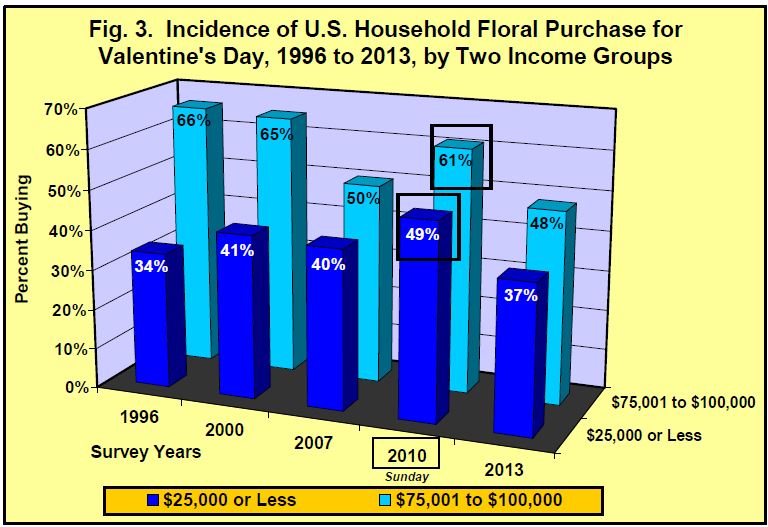
Thus, a weekend Valentine’s Day expanded consumer floral purchasing at both ends of the income ladder. Another trend worth noting in Figure 3 is the healthy level of Valentine’s Day floral purchasing among the higher income consumer group during the latter “Clinton Boom Years” of 1996 thru 2000, perhaps a possible target going forward.
“Mature Households” Influence Weekend Purchasing
While the youngest households (age under 35) show the highest incidence of floral purchase for Valentine’s Day across all survey years, it is the more mature consumer segments (age 55 to 64, and age 65 and older) that show heightened floral purchasing for Valentine’s Day 2010, when the holiday fell on the weekend (Figure 4). However, the purchasing gain attributed to a weekend Valentines Day for these two age groups is modest (around five percentage points each). For the two eldest household segments, the general “building trend” in Valentine’s Day floral purchasing across the survey years, initially in 2000 with the 55 to 64 age group, and then later in 2013 with the 65 and older age group, is likely influenced by the “baby boomer generation” moving thru the survey periods, a traditionally strong group of floral purchasers.
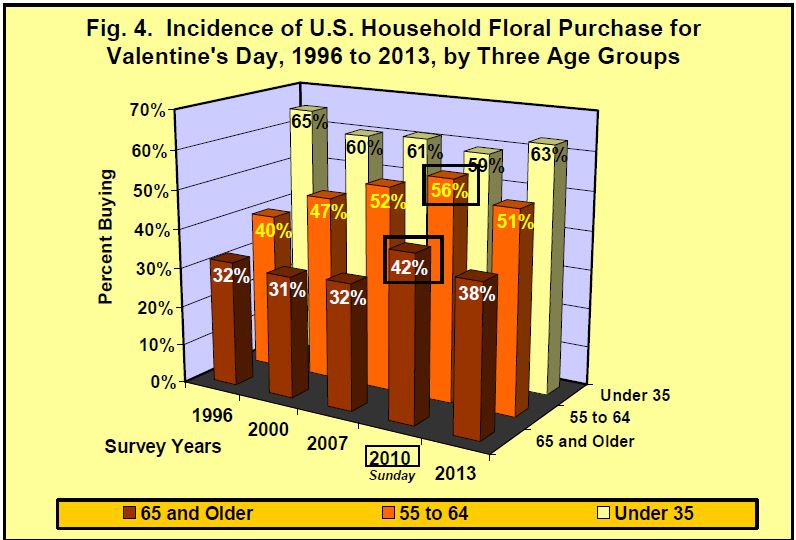
Single Male Households Influence Weekend Purchasing
Figure 5 shows the profile of Valentine’s Day floral purchasing across the survey years for households composed of a single female, a single male, and households with more than one adult living in the household. Single male households drove floral purchasing substantially higher for the weekend Valentine’s Day in 2010 (about ten percentage points higher), compared to most survey years with weekday holidays.
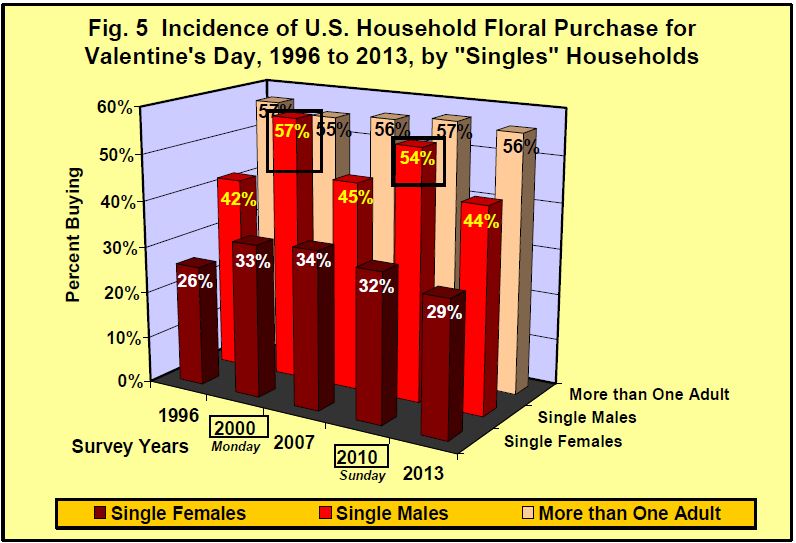
An exception to this was in 2000, when the Valentine’s Day holiday fell on Monday, in which single males also exhibited heightened floral purchasing, the only consumer group to do so. This market finding either challenges the weekend Valentine’s Day effect, or it extends the “theory” to include the following Monday as well. The year 2000 heightened floral purchasing for single males could be attributed to more impulse purchasing by singles males on the weekend, prior to the Monday holiday, rather than pre-planned floral purchases for Valentine’s Day. Or the heightened Monday purchasing could simply be due to the single male’s girlfriend (or boyfriend) having the entire weekend to remind him that Valentine’s Day is just around the corner!
Concluding Remarks
The floral market findings profiled in this P&P report again remind members of the floral industry to remain vigilant and continually focus on the market, and seek to understand the market opportunities that are unfolding for the floral industry. The consumer floral market changes over time, and our marketing and business strategies need to adapt to best exploit these new market opportunities. While not specifically addressed in this report, the dynamics exhibited in the key retail floral channels over the past ten years or so (detailed in the P&P seminar), likely has influence on the current weekend Valentine’s Day effect, possibly enhancing consumer weekend holiday floral purchasing. Future P&P tracking research will verify and quantify these important floral market dynamics, and in turn, assist members of the floral industry in gaining a better understanding of consumer floral purchasing behavior for market advantage.
For the full reports with citations, please visit the Prince & Prince website.


